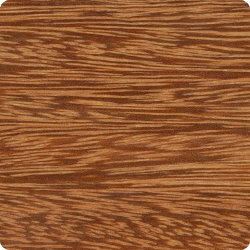Detailed Specs: Tatabu
Scientific Name: Diplotropis purpurea
Family: Papailionaceae
Other Names: Botonallare, Peonia (Venezuela), Aramatta (Guyana), Zwarte kabbes (Suriname), Coeur dehors (French Guiana), Sapupira, Sucupira (Brazil)
The Tree
Commonly 90-100 feet in height and 16-24 inches in diameter however, it can reach up to 40 inches. The bole is usually straight, cylindrical, unbuttressed and clear to lengths of 60-70 feet.
The Wood
General Characteristics: When freshly cut the wood is dark chocolate brown, turning into a lighter brown upon drying. It is occasionally greyish brown with fine lighter parenchyma stripes which is sharply demarcated from the yellowish or whitish sapwood. The wood texture is coarse with the grain being slightly interlocked or slightly wavy. Luster is medium to high and is golden, often waxy without a distinctive odour or taste.
Weight: Specific gravity (Oven dry weight/ green volume) 0.78; air dry density 58pcf.
Drying and Shrinkage: This wood is moderately difficult to air season and rapid drying results in some warping and checking. This will occur considerably in kiln drying unless a mild schedule is used. T7-B3 is suggested for 4/4 stock. Shrinkage green to ovendry: radial 4.6%; tangential 7.0%; volumetric 11.8%.
Working Properties: The wood is moderately difficult to work and resulting surfaces, especially in planing, are fair to poor due to the coarse texture and frequent grain irregularity. The wood turns well and takes a good finish if filler is first applied.
Mechanical Properties: (2-cm standard)
|
Moisture |
Bending Strength (psi) |
Modules of Elasticity (1000 psi) |
Maximum Crushing Strength (psi) |
| Green (73)
12% 12% |
17,400
20,560 20,900 |
2,680
2,870 3,140 |
8,020 12,140 12,300 |
Janka side hardness 1980 lb. for green material and 2140 lb. at 12% moisture content. Forest Products Laboratory toughness average for green and dry material is 201 in-lb. (5/8-in specimen).
Durability: The heartwood is rated very durable to resistance against white and brown rot fungi, and it is moderately durable and highly resistant to attack by dry wood termites. However, it does not resist marine borers.
Distribution: In the highland region of the Guianas and in Para and Amazonas in Brazil. Fairly common in French Guyana and infrequent in Guyana and Suriname.
Preservation: If there is good end grain exposure, absorption and penetration of preserving solutions are adequate using either open tank or pressure vacuum systems.
Uses: Due its decorative appearance and is of interest for turned work and as a veneer for inlays in high grade furniture. It is su itable for exterior and interior joinery, turnery, panelling and toll handles. This wood is also used for construction work, boat building, railroad crossties and tool handles.
References
– Chundnoff, Martin (1984), “Tropical Timbers of the World.” USDA Forest Service Ag. Handbook No.607.



